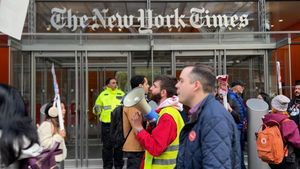Firefighters from Santa Clara County, stationed to combat the raging Park Fire, recently had to spring to action to save the life of a seven-year-old girl. The incident occurred at the Best Value Inn on Broadway Street, where officials report she was found unresponsive in the hotel pool.
The courageous firefighters, who were resting away from the intense fire lines, quickly transformed from their roles as fire combatants back to lifesavers. Fire Captain Daniel Lozano and his team, which included Engineer Carlos Hernandez and Firefighter/Paramedic Marcus Ortega, jumped at the chance to assist.
It all started when Ortega, who had only recently joined the team and was still on probation, spotted some unusual activity at the pool. Recognizing something might be seriously wrong, he alerted his fellow crew members, and they immediately rushed to the scene.
Activations of their emergency lights accompanied their rapid response, showcasing the urgency of the situation. Engineer Hernandez also called for backup by contacting 911, and soon additional support rolled out from Chico Fire and Chico Police.
The firefighting crew wasted no time, pulling the little girl from the water and administering lifesaving techniques such as CPR and ventilation. This rapid response undoubtedly played a pivotal role in her recovery.
This rescue operation is just one of the many challenges faced by fire crews battling the devastating Park Fire, which has been burning for weeks. Covering over 429,200 acres across four counties, the fire has caused widespread panic and devastation.
The Park Fire began on July 24, ignited under alarming and catastrophic conditions when Ronnie Dean Stout II pushed his burning car down an embankment. It’s shocking to think how quickly flames spiraled out of control, reaching over 353,000 acres within just three days.
By the end of the first week, it had already made its way onto the list of California's top four largest fires. But for residents of Northern California, this isn’t just another statistic; it’s their homes, their forests, and their lives on the line.
Low humidity, high winds, and soaring temperatures fueled the rapid spread of the fire. These challenging weather conditions, exacerbated by climate change, made the firefighting efforts even more strenuous.
According to Cal Fire, the state experienced higher-than-normal temperatures and significant dry vegetation during the summer. This unsettling combination has made wildfires increasingly common and difficult to manage.
A new report from NOAA highlights the stark reality: there’s been over five-fold growth in wildfire areas from 1996 to 2021. Climate change is at the heart of this increase, as human activities have played a significant role.
This year is proving to be particularly grim for California, as wildfire activity has jumped massively compared to previous years. Wildfires are on course to burn more acreage than ever before, with reports indicating 2,816% increase by the end of July alone.
Butas fire crews work tirelessly to put the flames under control, they also face emotional and physical strains. Many are compelled to abandon their families and personal lives to tackle these monstrous fires, risking their well-being for the sake of others.
The life-threatening situation faced by the young girl underscores the dangers present within the firefighting efforts. Each incident they tackle can become life or death, just like the challenging conditions presented by the Park Fire itself.
Wildlife and the environment are also paying the price. Reports show many animals are being displaced from their natural habitats, and ecosystems suffer irreparable damage when disasters like these occur.
The Park Fire serves as yet another painful reminder of how interconnected the climate crisis and fire activity are. Communities are left grappling with the fallout as they assess the longer-term impacts of these fires.
Firefighters on the front lines are committed to battling this devastation, often putting their own safety on the line. Yet, they are not alone; support from the community remains resilient, as neighbors come together to offer assistance.
Despite these efforts, the Park Fire continues to be only at 39% containment. Local agencies reckon it's going to take not just time, but complete community support to recover fully.
Every summer, the firefighters find themselves facing longer and tougher battle than before. Climate predictions indicate above-normal temperatures will result in high fire risks continuing throughout the year.
So as residents anxiously watch the flames flicker nearby, the firefighters charge onward, focused on one life at a time. Thanks to their swift actions, the story of the young girl had a glad ending, but many more lives hang painfully on the balance of every fight they face.
The Park Fire is more than just another headline; it's deeply woven with issues surrounding climate change, community resilience, and the undying spirit of those meant to serve others. How much longer can communities bear this strain before it becomes too much?
Reflecting on the efforts of those involved, the story of survival persists. Because at the end of the day, it’s the lives saved and lessons learned from the ashes of tragedy, driving the firefighters forward against the relentless flames.
The Park Fire, though devastating, has bolstered camaraderie and support among local firefighters and communities alike. This incident highlights the need for solidarity and proactive responses to broader climate challenges.



